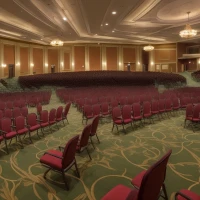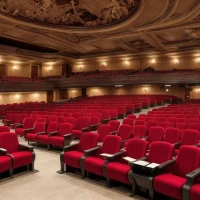Dive into the heart of ancient culture with this revelatory examination of Greek theater architecture and functionality. From the sweeping rows of stone seating to the vital acoustics that carried dramatic dialogues to the backmost seats, Greek theaters are archeological and artistic treasures. In this comprehensive guide, we unlock the secrets of Greek theater design, focusing on its intricate seating chart, analyzing its purpose, and revealing how these ancient amphitheaters continue to influence modern venue design. Prepare to be transported back in time as we graph the gradients of history, providing you with a detailed seating chart guide unlike any other.
The Genesis of Greek Theater: Foundations of Performance Art
Greek theater, an enduring symbol of ancient Grecian life, was not merely a space for entertainment but a vital component of cultural expression and civic pride. The amphitheaters were masterfully crafted, ensuring every member of the society, from the elite to the common man, could gather and partake in the spectacular performances. Let’s dissect the layers of these historic edifices to understand their grandeur.
Unearthing the Anatomy of Ancient Architecture
Origins of the Open-Air Marvels
The history of Greek theater is deeply rooted in ritual and religion, evolving from festivities dedicated to gods like Dionysus. These amphitheaters were meticulously designed, reflecting the sophisticated understanding of acoustics, aesthetics, and communal inclusivity that ancient architects possessed.
Architectural Acumen: Calculating the Optimal Viewing Experience
A unique feature of Greek theater is the impeccable sense of geometry and graphing utilized to create a seating arrangement that allowed for optimal sightlines. Every seat, from the prohedria reserved for dignitaries to the upper echelons meant for the general populace, was strategically placed.
Harnessing the Power of Graphing in Greek Theater Layouts
Seating Chart: Crafting an Inclusive Experience
Greek theater designers were early adopters in utilizing graphing techniques to ensure that the tiered seating arrangement—known as the theatron—provided an unobstructed view of the skene (stage) from every angle. This focus on inclusivity and shared experience is a testament to the democratic ethos that permeated Greek society.
Mathematical Precision: Geometry in Stone
The precision of the seating arrangement and the gentle curvature of the amphitheater’s design required a deep understanding of mathematics and geometry, which ancient Greek thinkers and mathematicians were renowned for.
The Core of Greek Theater: Dissecting the Seating Plan
Understanding the anatomy of a Greek theater’s seating plan is akin to decrypting a map of cultural and social hierarchies. Each section held its significance and was a piece of the greater whole that orchestrated the symphony of communal viewing.
The Orchestra: The Heartbeat of Action
Central Stage for Choral Narratives
At the center of the theater was the orchestra, the circular space where the chorus would narrate, dance, and interact with the actors. Its central location was pivotal—graphically and functionally—as it cemented the communal feel of the performances and allowed the audience to be enveloped by the action.
The Theatron: Where Spectators Become a Part of History
Designing for Democracy: Equity in Viewing
Every theater-goer was entitled to a detailed seating chart that honored the democratic principles of equal viewing. No seat was a bad seat in the Greek theater’s seating chart, a feat that modern venues still strive to achieve.
Graphing Visibility: Calculated Inclines and Acoustic Mastery
The rise and run of each amphitheater tier were graphed to perfection, ensuring that sound traveled from actors’ mouths to the spectators’ ears with crystal clarity, and the sight of the performance was preserved no matter the distance from the stage.
The Skene: Backdrop and Storytelling Canvas
Visual Mastery and Graphical Design
The skene, often a building with decorated facades, provided the backdrop for theatrical narratives. It was graphically aligned with the seating layout to complement the visual experience for every attendee.
From Chorus to Choregos: Deciphering Class and Prestige in Seating Arrangements
Diving deeper into the seating chart of a Greek theater reveals much about the stratified social structure of ancient Greece. Each section not only offered a place to sit but also signified societal standing and communal roles.
The Prohedria: Seats of Honor
Prestige Etched in Stone
Reserved for priests, magistrates, and other individuals of high social esteem, the prohedria were front-row seats, often distinguished by inscriptions and ornate design. These seats underscored the intersection of civic duty, religion, and the arts within Greek culture.
The Analemmata: Building Altitude, Building Community
Structured for Inclusiveness and Interaction
The analemmata, the retaining walls that supported the tiered seating, facilitated a sense of belonging and interaction among the audience members, breaking down barriers between different societal echelons through the shared experience of theater.
The Influence of Greek Theater Today: Modern Seating Chart Philosophy
The legacy of ancient Greek theater is undeniable when we peruse modern seating philosophies. The commitment to optimal acoustic design, excellent sightlines, and communal inclusivity laid down by Greek amphitheaters has seeped into the DNA of contemporary performance spaces.
Acoustic Reverberations: A Legacy Carved in Stone
Crafting Soundscapes Fit for the Gods
Modern stadia and performance venues continue to draw on the acoustic marvels pioneered by Greek theater architects, implementing design features that promote clarity and immersion in the audience experience.
Engineering Sightlines: Lessons from Ancient Graphing
Seating Chart Symmetry: Balancing Form and Function
Today’s architects employ sophisticated graphing algorithms to replicate the balanced sightlines of Greek theaters, ensuring a visually rich experience for all audience members, harking back to the detailed seating chart principles of ancient times.
Conclusion: Mastering the Blueprint of Antiquarian Elegance
Embark on a journey through history as we unveil the genius behind the design of Greek theaters and the harmonious relationship between architecture, sound, and society. From the sophisticated seating chart configurations to the graphing techniques that shaped these historic spaces, the secrets of the Greek theater are now laid bare, inviting us to appreciate the combination of form, function, and communal joy that permeates these ancient marvels. As we draw lessons from these structures, it becomes evident that the careful consideration of venue design remains an art form dedicated to elevating the human experience, making Greek theaters not only relics of the past but teachers of the future.









